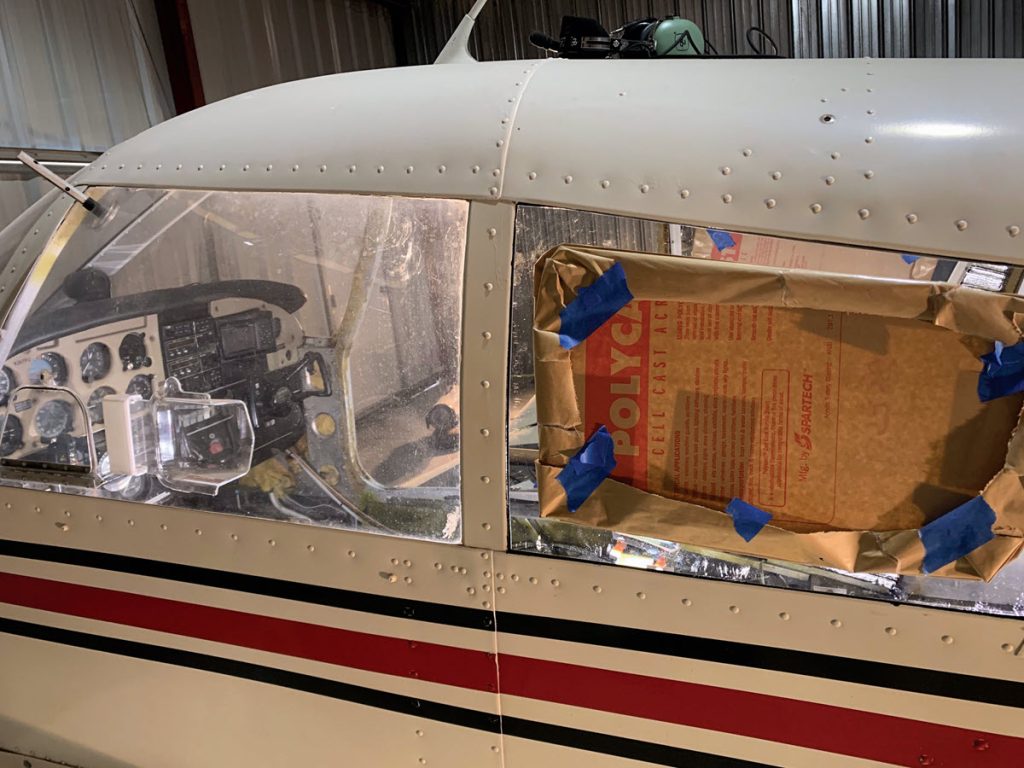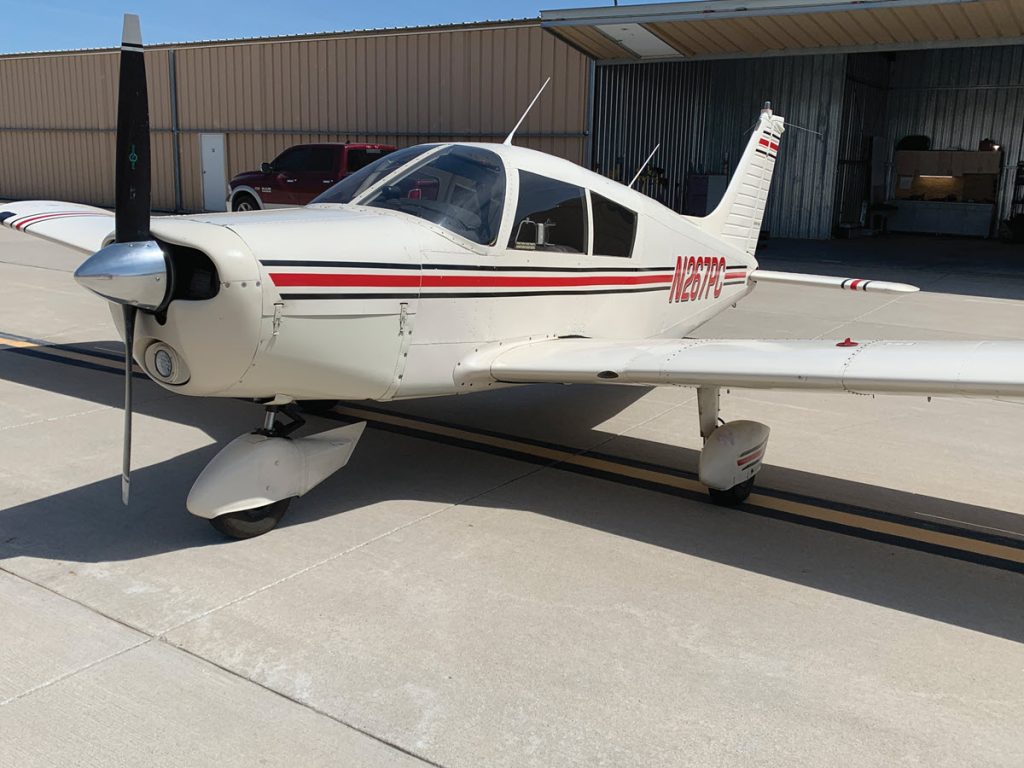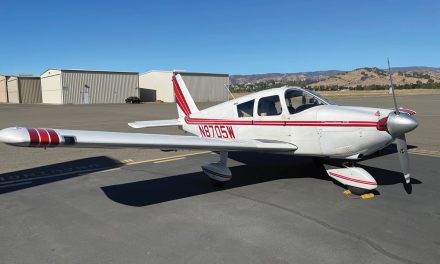A Project That Started Small But Kept Growing
David Arnold has been flying his Cherokee 140 for several years now and loves its performance. Not long after purchasing it, he had to make a tough decision about whether to keep it or move on to another plane. He feels he made the right decision keeping it, and he’s been very happy with the results.
He bought and began flying his 140 while he was still working on his private pilot’s license. “I started flying a Cessna 172 for training for my private,” he said. “But I decided I wanted to fly my own plane for my private, so I bought this plane from a gentleman at my home airport, and I flew it for over a year. I finished up my private and then I flew for about another six months, and the engine timed out and it just kind of went kaput.”
David gave considerable thought about his next step, whether to repair the 140 or replace it with something else. It was a big decision, not only financially, but in settling on what he wanted long-term regarding his plane’s mission and capabilities. After several months and several long discussions with his wife, he determined he would stay with the 140 and rebuild the engine. With that, he kicked off a series of upgrades that took more than a year and a half, finishing it just in time for Oshkosh 2021.
The Engine Rebuild
He got the work underway at his local shop. It was an extensive project, but they were able to get the job done fairly quickly. “We started rebuilding the engine in the summer of 2019, and it was complete in September 2019,” David said. “The work was done by my own mechanics, headed by Ralph Holiday. We tore the engine all the way down, sent off the cams, the crank, and the case for testing. The only thing that was used from the engine was the case. Everything else was brand new.”
A Bigger Vision
Then it was time for David to take N267PC for its first flight after the rebuild. “I got it back together and somehow talked my wife into flying it to Sedona, Arizona, from Kansas City to break the engine in. When that trip was complete, she’d had enough flying a 140 to Sedona that I mentioned perhaps we can get bigger and faster.”
That got the couple thinking about doing even more work on the 140. “It was actually her idea to go ahead and make this airplane the way I wanted it and wait three to five years in order to get bigger and faster. And we could just continue flying this plane. It served every purpose that we had. I had a new engine, so I thought this airplane would last several more years if I so chose,” he said.
Before long, David was inspired to improve his avionics, add an autopilot, and go IFR. “After the engine rebuild, I started looking at the interior and I decided I wanted to upgrade the panel a little bit, too, and the upgrade just exploded from there.
“I went with the Aspen E5, and then I flew with a friend in his 172. He had autopilot, and he said, ‘Check that out!’ So I played with the autopilot and that’s what put it over the top.”
“I had my private for a couple of years by that time and decided that I was going to get my IFR and ‘we’re going to make this plane IFR.’ I was going to do the rest of my training to wherever I decide to stop on my certifications. I would do it in my own plane and this one here, I now know inside and out.”



Interior
When it came to the interior work, David chose to do the work himself rather than hire it out. “I did the interior personally. I watched a few YouTube videos. I talked to Dodd Stretch at Airtex, where I got the materials from. He gave me quite a bit of instruction at different times and the rest of it was trial and error.”
Putting in new insulation was an important part of the interior upgrade. It only made sense to do that while he was doing the other interior work. David got most of his insulation from Airtex and fortunately helpful support from them, too. “I had a couple questions on which size of insulation to use where, and there was a lot of wiring where I couldn’t use the thicker insulation. I think the thicker is 3/4-inch and the thinner, a 1/2-inch, if I remember correctly.
“A lot of the wire I could get the 1/2-inch behind, and then I could double up, up to the wiring with another layer of 1/2-inch, so some of it got more insulation than what was needed, and some of it didn’t get quite as much.”
“It was satisfying to do the interior myself, and Dodd and Mark at Airtex were such great help that I could call and — not being an upholstery guy — I had some dumb questions, a lot of dumb questions, but they walked me right through it, and had no qualms with answering whatever question I had.
“The headliner really made me nervous, and I called a couple times, and it still made me nervous, and he said this is what you do. I called back on a Friday and talked to Mark, and he gave me a couple other pointers and after all that, it took about an hour. It was so easy that I made it bigger than what it needed to be.”
“I did the floors through Airtex, too. I took out absolutely everything, including the windows. I replaced all the windows except for the windshield. For the pilot side and door, I used 1/4-inch windows, and looking back, I wish I had used the same thickness for the back two. I took it all out under the watchful eye of my mechanics. They signed off and made sure I did everything correctly, obviously, but I stripped it all the way down and cleaned it all out and resprayed zinc chromate as I was putting it all back together.”
David replaced all the plastic from Vantage Plane Plastics. They were extremely helpful too. He bought all new seatbelts, the front two with shoulder belts and new inertia reels. He also took the seats all the way to the metal and had to get a few places rewelded from years of use on them, and he oiled the cables and repainted the frames.
Paint
The paint isn’t new, but David has done some significant work on it since he bought the plane. “We touched up the paint and kind of cleaned it up a little bit. As we were waiting for other things to dry, we would paint different parts.
“It’s been repainted sometime in its life. It looks like a latex house paint. With it being so thick, some places there were runs. We scraped off a lot of runs and we touched up and sanded out a few things here and there, as much as I feel comfortable with doing. I went to the local auto body supply shop, and they mixed up matching paint and did a phenomenal job. It matches perfectly. We have repainted quite a few parts and pieces, and you can’t tell the difference.”
Lights and Strobes
Next, David and his mechanics added the Whelen lights and strobe. “We had to pull extra wire out of the wing tips into the tail,” he said. David worked in the tail, while the mechanics worked outside. It took a team effort, but it was one that was worth the time and cost, as it gave the plane one more level of safety.
Panel
The panel took several rounds to get it to the point where David was satisfied. “The panel itself is new,” he said. “I had the original panel in there. I took it to the avionics shop, and he put in everything that you see there. But some of it I didn’t like the location where it ended up just because of the old panel. I spoke to a different avionics shop up in Omaha, and they said, ‘We can make you one, and you could put stuff where you want it.’ So we sat down and drew it out, and this is the final product.”
Clock
At the far left, above the dual USB plug, is a clock with geo sensor, timer, temperature inside and out, and Zulu and local time.
Aspen Evolution E5
David loves his Aspen Evolution. “It serves all the purposes that I need,” he said. “On my next airplane, I’ll have a couple of them.”
Garmin 530W and Bendix King KX 155
The KX 155 is a backup to the Garmin 530W. David bought the KX 155 on eBay with the localizer. He purchased the used 530 through his first avionics shop.
Stratus Appareo
The Stratus is an ADS-B In and Out transponder.
PS Engineering
The audio panel is a PS Engineering PMA6000B unit.
Bendix King AeroCruze 100 Autopilot
The autopilot reduces pilot fatigue, especially on longer trips, and adds safety. The emergency autopilot level button helps to bring the aircraft to a wings-level position.
There are two Stratus USB ports, one on each side of the panel. The panel also includes new switches for avionics, Aspen power, autopilot power, and a switch to change the autopilot from the Aspen to the Garmin.
David’s Advice on Restoration
David offers advice for other owners based on his experience. “One of the first things I would tell owners is to have all their ducks in a row and know what they want from the very get-go because I would jump in there, do a little bit, and then I would read something or see something, and I would back up and redo it. Then I would go forward a little bit further and then I would do it again and back up again. The panel was a three-shot process. So make sure you have everything lined out exactly what you want. There were a couple of things that I waited for, so I wasn’t back in the air as fast as I wanted to be.
Conclusion
David learned a lot from his restoration project, but he doesn’t plan on making his 140 the final stop in his plane ownership. He wants to move up sometime in the future when the time is right. “My Cherokee 140 is a practical airplane, and it serves every purpose that I’m going to need it for, and I’m going to fly for three or four more years and then reevaluate. I’d like to jump up to a Dakota or even a Lance. But I want to get all my training out the way this airplane.
“I did as much work on it as I could, and the mechanics I know well enough, even starting out, that they would allow me to do just about anything. Some of it they had to help with, and I did my work under their watchful eyes. So I saved a lot of money doing it that way, and now I know the airplane inside and out.
“I have been back in the air for over a year now. Of course there are things I would do a little differently, change, or even add. I think it is time to shop a little, but the wife and I are really enjoying everything about this plane and look forward to continuing to fly it for a couple more years.”
There’s no doubt that the knowledge and experience David gained and the money he saved will come in handy in purchasing and maintaining his next set of wings.
The Crash That Saved David’s Life
Between the time this article was written and it was being readied for press, David had an on-the-ground mishap with his Cherokee, caused by a previously undetected brain tumor, making his beloved Cherokee unflyable. There were no permanent injuries, and the plane is covered by insurance, so there’s much to be grateful for. The tumor was removed, and his flying days are far from over, but it is also a good reminder that what matters most in life are relationships, not things.
Asked whether he still wanted this article to be published (after all, a loss like that is painful), he said, “Yes, I would be honored to have my plane featured in an article. It may not be flyable any longer, but I did enjoy it while I had it, and I am looking hard at perhaps a Dakota next time around.” Even being somewhat of a private person, he does not want his temporary misfortune to deter anyone that is interested in pursuing their license and aviation career from chasing their dreams. That’s an amazing testament to his generosity in sharing about his plane’s renovation for other members to benefit from.
And he’s making the most of his time until he has his next plane and is up in the air again. “I was neck deep and weeks away from getting my IFR when this took place,” he said. “Although it slowed down the actual flying, I’m working on getting as many of my ground school courses out of the way.” He’s passed his written exam for his IFR, and has started on his commercial, with plans to add CFI and CFII. I have some time on my hands, so I’m going to put it to good use.”
Thank you, David, for setting such a good example dealing with adversity in a positive, constructive way. Best wishes to you as you move on to the next steps in your aviation adventure!

















